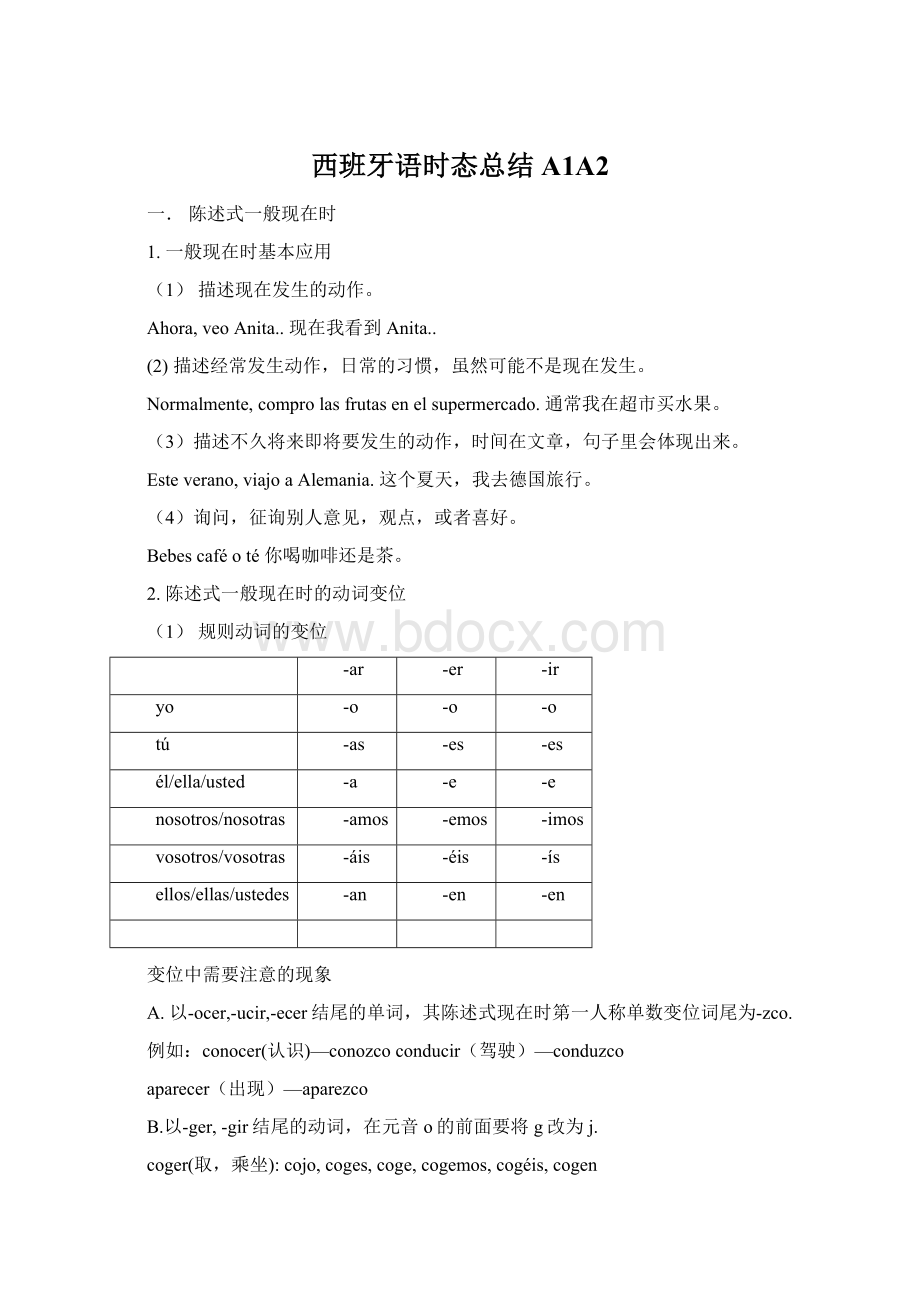西班牙语时态总结A1A2.docx
《西班牙语时态总结A1A2.docx》由会员分享,可在线阅读,更多相关《西班牙语时态总结A1A2.docx(16页珍藏版)》请在冰豆网上搜索。

西班牙语时态总结A1A2
一.陈述式一般现在时
1.一般现在时基本应用
(1)描述现在发生的动作。
Ahora,veoAnita..现在我看到Anita..
(2)描述经常发生动作,日常的习惯,虽然可能不是现在发生。
Normalmente,comprolasfrutasenelsupermercado.通常我在超市买水果。
(3)描述不久将来即将要发生的动作,时间在文章,句子里会体现出来。
Esteverano,viajoaAlemania.这个夏天,我去德国旅行。
(4)询问,征询别人意见,观点,或者喜好。
Bebescaféoté你喝咖啡还是茶。
2.陈述式一般现在时的动词变位
(1)规则动词的变位
-ar
-er
-ir
yo
-o
-o
-o
tú
-as
-es
-es
él/ella/usted
-a
-e
-e
nosotros/nosotras
-amos
-emos
-imos
vosotros/vosotras
-áis
-éis
-ís
ellos/ellas/ustedes
-an
-en
-en
变位中需要注意的现象
A.以-ocer,-ucir,-ecer结尾的单词,其陈述式现在时第一人称单数变位词尾为-zco.
例如:
conocer(认识)—conozcoconducir(驾驶)—conduzco
aparecer(出现)—aparezco
B.以-ger,-gir结尾的动词,在元音o的前面要将g改为j.
coger(取,乘坐):
cojo,coges,coge,cogemos,cogéis,cogen
exigir(苛求):
exijo,exiges,exige,exigimos,exigís,exigen
C.以–guir结尾的动词,在元音o的前面时要将gu改为g.
distinguir(区分):
distingo,distingues,distingue,distinguimos,distinguís,distinguen
D.一些动词在变位后需要加上重音符号
enviar:
envío,envías,envía,enviamos,enviáis,envían
actuar:
actúo,actúas,actúa,actuamos,actuáis,actúan
(2)不规则变位
A.有共同不规则变化的动词
a.o→ue
acostarse(上床睡觉)soar(做梦)volar(飞翔)soler(习惯)volver(返回)poder(能够),contar(讲述,数),morir(死),dormir(睡觉)
volver(返回):
vuelvo,vuelves,vuelve,volvemos,volvéis,vuelven
b.e→ie
perder(丢失),sentir(感觉),sentarse(坐下),empezar(开始)preferir(偏爱)mentir(说谎)
pensar(想,思考):
pienso,piensas,piensa,pensamos,pensáis,piensan
c.e→i
pedir(请求,借)server(服务)elegir(选择,选举),seguir(继续)vestirse(穿衣服)
pedir(请求,借):
pido,pides,pide,pedimos,pedís,piden
d.u→ue
jugar(玩,游戏):
juego,juegas,juega,jugamos,jugáis,juegan
注意:
以上动词的变位在“我们,你们”的时候不用变化。
B.部分不规则动词的陈述式现在时变位
Ser(是)--soy,eres,es,somos,sois,son
estar(在,位于)--estoy,estás,está,estamos,estáis,están
ir(去)--voy,vas,va,vamos,vais,van
ver(看见)--veo,ves,ve,vemos,veis,ven
oir(听见)--oigo,oyes,oye,oímos,oís,oyen
saber(知道)--sé,sabes,sabe,sabemos,sabéis,saben
hacer(做)--hago,haces,hace,hacemos,hacéis,hacen
tener(有)--tengo,tienes,tiene,tenemos,tenéis,tienen
venir(来)--vengo,vienes,viene,venimos,venís,vienen
poner(放,放置)--pongo,pones,pone,ponemos,ponéis,ponen
traer(带来)--traigo,traes,trae,traemos,traéis,traen.
二.陈述式现在完成时(复合时态)
1.陈述式现在完成时的构成:
助动词+过去分词
A.助动词:
yo
he
nosotros/nosotras
hamos
tú
has
vosotros/vosotras
habés
él/ella/usted
ha
ellos/ellas/ustedes
han
B.过去分词
a.规则变位:
以-ar结尾的,去掉-ar,加上-adoestudiarheestudiado
以-er,-ir结尾的,去掉-er,-ir,加上-ido
代词式动词的陈述式现在完成时变位:
人称代词放于最前面,后面跟完成时变位levantarse(yo):
mehelevantado
b.不规则变位:
hacer–hechodecir–dichoabrir–abierto
poner–puestover–vistoescribir–escrito
morir–muertovolver–vueltocubrir–cubierto
esolver(解决)–resueltosatisfacer(满足)–satisfecho
romper(打破)–rotofreír(油炸)–frito
c.在现在完成时的时态中,过去分词无性数变化。
2.陈述式现在完成时的用法
(1)表示在尚未过去的时间里已经完成的动作
Estamaanahantrabajadoenelhuerto.
(2)表示已经完成,但对现在有某些影响的动作。
Estamaanahantrabajadoenelhuerto.
(3)陈述式现在完成时在日常生活中可用来谈论个人经历,常见的情况如下:
A.表达做过的次数:
vez连接相应的数字,表示次数,搭配现在完成时使用:
dosveces/muchasveces/algunasveces/variasveces
B.表示还未做过:
todavíano+动词(或:
no+动词+todavía)
表示还未做过某事(暗指以后将会做这件事或者该计划已摆上日程了)
例:
我还没去过美洲。
TodavíanoheestadoenAmérica.
C.表示从来没做过:
否定词nunca/jamás
与现在完成时搭配,表示从未做过某事(意思相近,但jamás的程度更深一些)
注意:
nunca/jamás的使用规则与nada/nadie/ningún/ninguna等词相同,直接放在动词前,或者放在加了no的动词后。
Nuncaheestadoallí.=Noheestadoallínunca.
Jamásheestadoallí.=Noheestadoallíjamás.
D.表示已经做过:
ya
3.现在完成时常见的时间短语搭配
(1)esta/este/estas/estos+时间单位(semana/mes/ao),搭配现在完成时,表示在一段还没有结束的时间内已经完成的动作。
(2)hace+时间短语表示“多久前”hacetreshoras三小时前
hace后面需要搭配时间段,不可以搭配一个时间点。
并且,该时间段距离说话时间较近,若是较久远的事,那么需要用过去式来表述。
(3)常见时间短语
hoy今天estamaana今天上午últimamente最近
último,aadj.最后的estefindesemana这个周末
estosfinesdesemana这几个周末esteao今年
estecurso这个学期haceunrato一小会儿前
三.陈述式简单过去式
1.动词的变位
(1)规则动词的变位
-ar
-er,-ir
yo
-é
-í
tú
-aste
-iste
él/ella/usted
-ó
-ió
nosotros/nosotras
-amos
-imos
vosotros/vosotras
-asteis
-isteis
ellos/ellas/ustedes
-aron
-ieron
例如:
amar—amé/amste/amó/amamos/ammasteis/amaron
(2)特殊不规则变位
A.常见动词:
estarhacertenerponerpoderpodersabervenirquerer,
词尾变化:
去掉词尾的-ar,-er,-ir,变为:
-e,-iste,-o,-imos,-isteis,-ieron。
词根变化--注意:
为方便理解,以第一人称yo的变位为例
estar–estuvepoder–pude
hacer–hicesaber–supe
tener–tuvevenir–vine
poner–pusequerer–quise
venir—vine-veniste-vino-vinimos-vinisteis-vinieron
haber:
hubehubistehubohubimoshubisteishubieronhaber
同陈述式现在时一样,只需用到第三人称单数的变位形式,因此只需记忆变位形式“hubo”即可。
decir:
dije,dijiste,dijo,dijimos,dijisteis,dijeron
producir:
prodijeprodijisteprodijoprodijimosprodijisteisprodijeron
decir的陈述式简单过去时第三人称复数变位词尾为eron而非ieron。
ser和ir的陈述式简单过去时变位形式相同。
ser/ir:
fui,fuiste,fue,fuimos,fuisteis,fueron
dar:
didistediodimosdisteisdieron
ver:
vivisteviovimosvisteisvieron
B.第三人称单数和复数不规则
a.规则词尾+o变u的词根变化
morir:
morímoristemurió